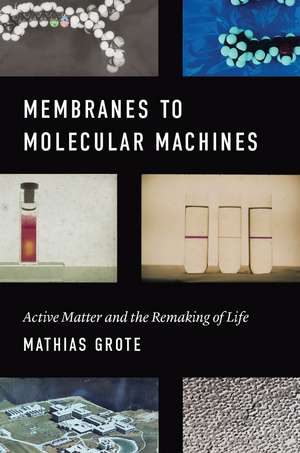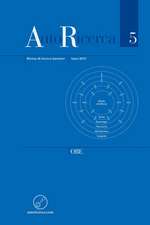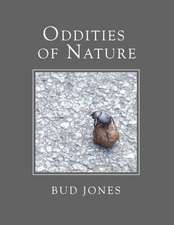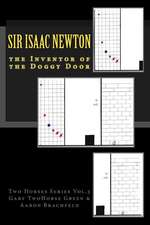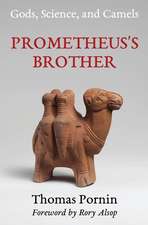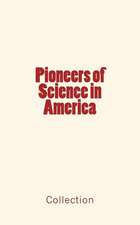Membranes to Molecular Machines : Active Matter and the Remaking of Life: Synthesis
Autor Mathias Groteen Limba Engleză Hardback – 9 iul 2019
Today's science tells us that our bodies are filled with molecular machinery that orchestrates all sorts of life processes. When we think, microscopic "channels" open and close in our brain cell membranes; when we run, tiny "motors" spin in our muscle cell membranes; and when we see, light operates "molecular switches" in our eyes and nerves. A molecular-mechanical vision of life has become commonplace in both the halls of philosophy and the offices of drug companies, where researchers are developing “proton pump inhibitors” or medicines similar to Prozac.
Membranes to Molecular Machines explores just how late twentieth-century science came to think of our cells and bodies this way. This story is told through the lens of membrane research, an unwritten history at the crossroads of molecular biology, biochemistry, physiology, and the neurosciences, that directly feeds into today's synthetic biology as well as nano- and biotechnology. Mathias Grote shows how these sciences not only have made us think differently about life, they have, by reworking what membranes and proteins represent in laboratories, allowed us to manipulate life as "active matter" in new ways. Covering the science of biological membranes in the United States and Europe from the mid-1960s to the 1990s, this book connects that history to contemporary work with optogenetics, a method for stimulating individual neurons using light, and will enlighten and provoke anyone interested in the intersection of chemical research and the life sciences—from practitioner to historian to philosopher.
The research described in the book and its central actor, Dieter Oesterhelt, were honored with the 2021 Albert Lasker Basic Medical Research Award for his contribution to the development of optogenetics.
Membranes to Molecular Machines explores just how late twentieth-century science came to think of our cells and bodies this way. This story is told through the lens of membrane research, an unwritten history at the crossroads of molecular biology, biochemistry, physiology, and the neurosciences, that directly feeds into today's synthetic biology as well as nano- and biotechnology. Mathias Grote shows how these sciences not only have made us think differently about life, they have, by reworking what membranes and proteins represent in laboratories, allowed us to manipulate life as "active matter" in new ways. Covering the science of biological membranes in the United States and Europe from the mid-1960s to the 1990s, this book connects that history to contemporary work with optogenetics, a method for stimulating individual neurons using light, and will enlighten and provoke anyone interested in the intersection of chemical research and the life sciences—from practitioner to historian to philosopher.
The research described in the book and its central actor, Dieter Oesterhelt, were honored with the 2021 Albert Lasker Basic Medical Research Award for his contribution to the development of optogenetics.
Preț: 321.10 lei
Nou
Puncte Express: 482
Preț estimativ în valută:
61.44€ • 64.15$ • 50.85£
61.44€ • 64.15$ • 50.85£
Carte disponibilă
Livrare economică 10-17 martie
Livrare express 28 februarie-06 martie pentru 39.81 lei
Preluare comenzi: 021 569.72.76
Specificații
ISBN-13: 9780226625157
ISBN-10: 022662515X
Pagini: 296
Ilustrații: 4 color plates, 23 halftones
Dimensiuni: 152 x 229 x 25 mm
Greutate: 0.54 kg
Ediția:First Edition
Editura: University of Chicago Press
Colecția University of Chicago Press
Seria Synthesis
ISBN-10: 022662515X
Pagini: 296
Ilustrații: 4 color plates, 23 halftones
Dimensiuni: 152 x 229 x 25 mm
Greutate: 0.54 kg
Ediția:First Edition
Editura: University of Chicago Press
Colecția University of Chicago Press
Seria Synthesis
Notă biografică
Mathias Grote is assistant professor at Humboldt-University Berlin, Germany.
Cuprins
Preface
Introduction: The Molecular Mechanical Vision of Life
Descartes among the X-ray machines? Mechanisms, molecular machines, and the epistemology of science
Life and matter—another history of the molecular life sciences after 1970
Constitutive and exemplary: Bacteriorhodopsin, membranes, and the rise of molecular machinery
A note on people and places, times and sources
Outline of the book
Life and matter—another history of the molecular life sciences after 1970
Constitutive and exemplary: Bacteriorhodopsin, membranes, and the rise of molecular machinery
A note on people and places, times and sources
Outline of the book
Part One: Taking Membranes Apart, Isolating a Molecular Pump
1. What Membranes Can Tell a Historian and Philosopher of the Life Sciences
2. Active Matter
Part Two: Remaking Membranes and Molecular Machines
3. Synthesizing Cells and Molecules—Mechanisms as “Plug-and-Play”
4. Biochip Fever: Life and Technology in the 1980s
Conclusion
Matter, activity, and mechanisms at the interstice of the chemical and the life sciences
Molecular machinery in past, present, and beyond
The bigger picture—membranes and molecular machines in the history of the life and the chemical sciences
Beyond life? Places and scientists after molecular biology
List of Abbreviations
Glossary
Notes
Sources
References
Index
Molecular machinery in past, present, and beyond
The bigger picture—membranes and molecular machines in the history of the life and the chemical sciences
Beyond life? Places and scientists after molecular biology
List of Abbreviations
Glossary
Notes
Sources
References
Index
Recenzii
"[A] highly original study . . . . Richly documented. . . . Life, his book persuasively shows, is not only transmission; it is also a way of being in the world and interacting with it."
"Grote blends insights and interests across the history, philosophy, and social study of twentieth century biology, with the additional explicit intention that these can also inform understanding of biological science in the present. . . . While in general this approach might sound very familiar to historians and philosophers of science, the specific way in which Grote achieves this study is quite novel. Rather than looking for a particular question, technique, or puzzle which organised research in his communities of interest, c. 1970s-1990s, he instead pursues a ‘genealogy of practices'."
“A deeply researched and well-supported history describing the synthesis of our modern understanding of biological membranes.”
"[Grote] gives structural biology time in the limelight—a break from the genetics and genomics frenzy of the modern era—and traces the history behind how the view of membranes evolved as electronic technologies gained traction among scientists. Packed with history and sprinkled with philosophical commentary, an occasional pun or two, and a smattering of German words, Membranes to Molecular Machines makes for a good read, informative and thought-provoking."
"In his book, Mathias Grote has covered a wide range of topics and philosophical aspects from the beginnings of membrane biology to the development of biochips. It is not only suitable for students and prospective scientists, but also offers teaching faculty an exemplary source of information about the beginnings of a small field of research that later led to new unforeseen methodological and conceptual developments."
"[Grote's] study not only illuminates a much broader field but also permits an analysis of the rise of the molecular life sciences as we know them today, with its orientation to molecular machinery. . . . This is a very readable book which explores how our understanding of the composition, structure, and function of membranes has evolved during the last century. The author successfully draws on his proximity to the field and his professional relationships with several of its key scientists to provide a rich history of the how the field advanced and to offer insights into the personalities and motivations of the major figures in the field."
"As an experimental researcher, I found Grote’s writing captivating and informative, with concise explanations of complex science, accompanied by pictures of the researchers along with images from their laboratory notebooks that tie in with the stories. Grote’s book makes for an intense read and will be of most interest to biological researchers, as well as to historians and philosophers of the life sciences."
"This book opens a new chapter in the history of the life sciences of the second half of the twentieth century. To this day, much of the historiography remained centered on molecular genetics with its heroes. Mathias Grote presents a different, immensely illuminating focus. Revolving around the concepts of 'active matter' and 'molecular machinery,' this book cannot only be read as an archaeology of nanobiology, but it is also a historically rich contribution to current debates around 'new materialism.'"
"Membranes to Molecular Machines is a masterful study of the hidden origins in chemical practice and an explanation of much of today's molecular biology. As Mathias Grote sheds light on how scientists unraveled molecular mechanisms related to energy, metabolism, and cognition, he expands the scope of our historical understanding and crucially enriches our theoretical armory. In giving scientists' investigations of active biomolecules center stage, and in arguing for a materialism based on chemical concepts and practices, Grote draws the lines of the historiography of the modern life sciences anew."
"In the 1950s and 1960s, the determination of the structure of DNA and the decipherment of the genetic code were revolutionary events in biology that have been often and well described. It is not the case for the process of molecularization of biology, which was initiated in the 1970s and transformed the whole discipline. In this book, Mathias Grote describes a lesser-known—but probably one of the most significant—episodes of this molecularization: the conversion of the monotonous structure of cellular membranes into an organized ensemble of superb macromolecular machines. It was a leap in our understanding of the functions of cellular membranes, and one that opened a door to new therapeutic approaches to numerous diseases."
"How have we come to understand life and our own bodies in terms of molecular machines? This question drives Mathias Grote's fascinating inquiry. Focusing on cell membranes, channels, and pumps as paradigmatic objects of analysis and synthesis, Grote forcefully argues that there has always been more than genes to the molecular study of life. This book is a major new contribution to both the history and philosophy of recent biology and our understanding of a molecular vision of life."
"According to the dominant narrative in the history of biology, the most important developments in the last half of the twentieth century centered on DNA and genetics. In Membranes to Molecular Machines, Mathias Grote argues that this history omits other areas of the life sciences not illuminated by the spotlight of the DNA saga. One such area is what Grote calls the 'materialization' of membrane machines. Using the fascinating story of bacteriorhodopsin as a case study, he follows the discovery of the protein through its structural determination by electron microscopy to the description of its function as a light-stimulated proton pump. Along the way, he reviews the development of the biological membrane concept from early models to reconstitution studies, and impressively exploits interviews and the personal archives of leading investigators to construct his account. In this way, he produces a fuller and more accurate view of the history of biology in the twentieth century."
